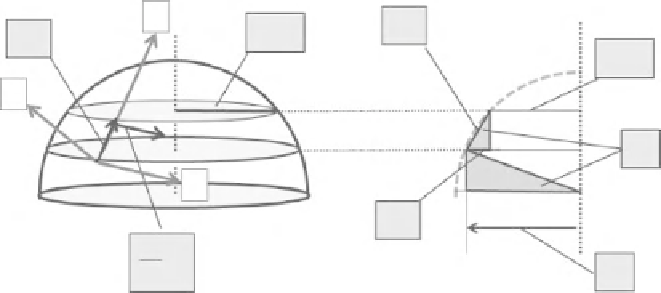Geoscience Reference
In-Depth Information
Y
v
d
t
r
+
d
r
v
d
t
r
+
d
r
Z
q
X
Figure 16.6
The rate of
change in velocity in the X
direction required to
conserve angular momentum
when a parcel of air moves in
the Y direction at a velocity
v
.
d
r
u
t
d
t
r
Note: In this case
d
r
has a negative value:, i.e.
d
r
=
−
[
v
.
d
t
.
sin
(
q
)]
Consider next a particular case shown in Fig. 16.6 in which a parcel of air with the
same volume and density initially has no velocity when viewed from a frame of
reference stationary on the surface of the Earth (i.e.,
u
= 0). In this case, Equations
(16.26) and (16.27) give the angular momentum,
, of the parcel as:
Γ′
(
Vrr
)
(16.28)
Γ′ =
r
ω
Suppose this parcel now begins to move with a fixed velocity
v
in the Y direction.
At a short time,
dt
, later the parcel has moved a distance (
vdt
) along the Y axis and,
because the parcel of air is constrained to move in a plane parallel to the surface of
the Earth, the distance between the parcel and the axis of rotation of the Earth has
changed to (
r+dr
), where
dr = −v dt
sin(
q
), see Fig. 16.6. (Note the radius
r
decreases in this case, so
dr
is negative.) Because angular momentum must be
conserved, the (true) velocity of the parcel must also have changed, by an amount
[
dt
(
∂u/∂t
)], such that the new angular momentum is equal to
, i.e.
Γ′
{
}
{
}
(
V r vt
)
si ( )
⎡
(
u t t
)
r vt
si
( )
⎤
(
V rr
)
(16.29)
r
−
d
q
∂
∂
d w
+
−
d
q
=
r w
⎣
⎦
a
a
It can be shown by multiplying out the left hand side of Equation (16.29) and can-
celling terms that:
∂⎛⎞
u
2 i
v
()
(16.30)
=
wq
⎜⎟
⎝⎠
∂
t
axis specific
In similar way, if a parcel of air, previously stationary in a frame of reference sta-
tionary on the Earth, suddenly begins to move with a velocity
u
along the X axis,
angular momentum conservation requires that it then accelerates along the Y axis
in order to move farther from the axis of rotation. In this case geometric





